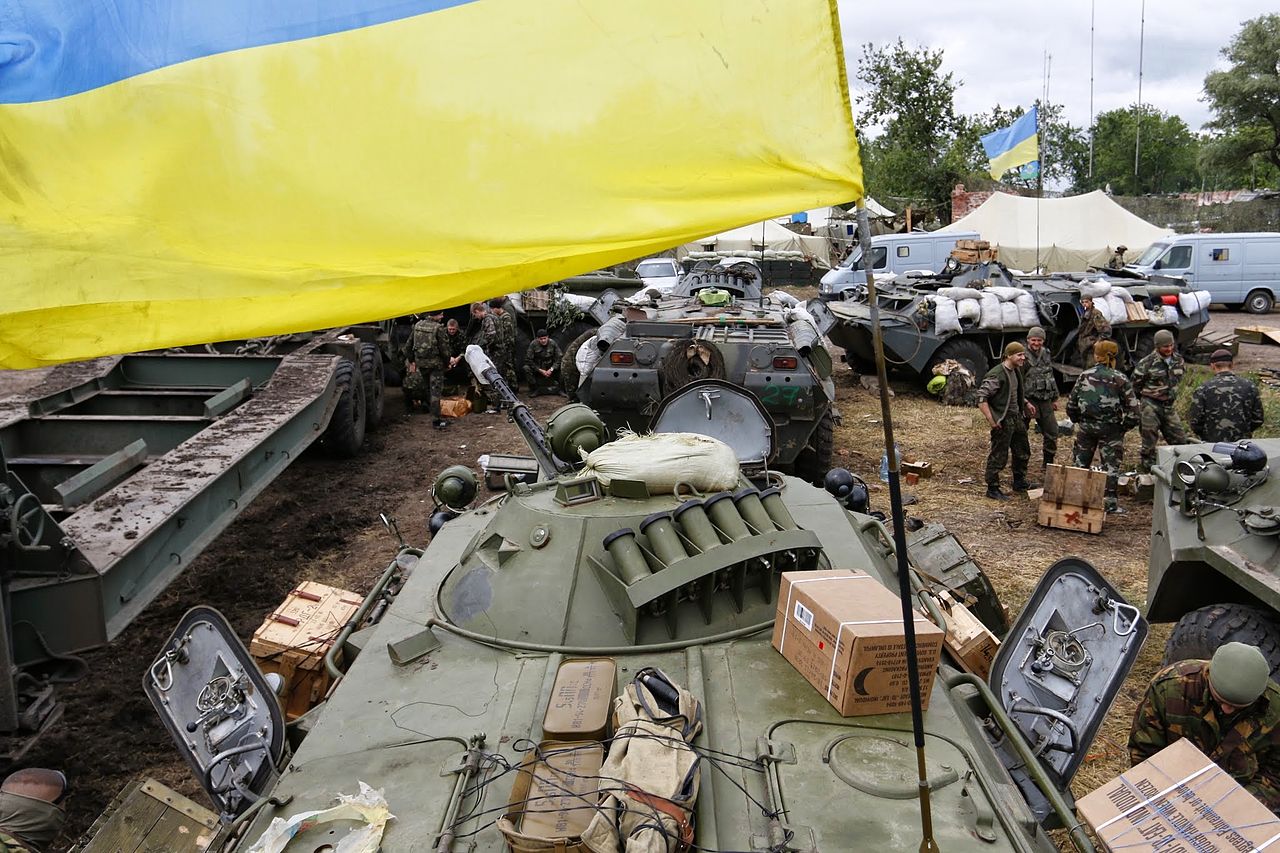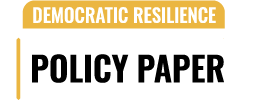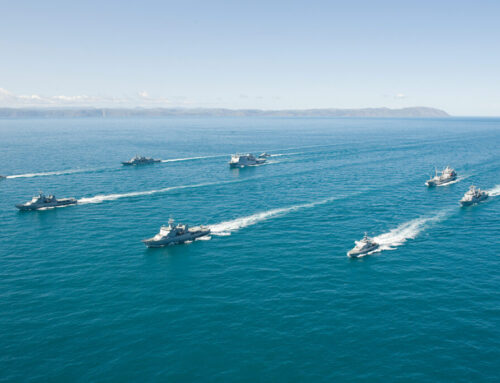Autor foto: Domena publiczna

Russian information war – Ukrainian front
April 26, 2016
Author: Adam Lelonek




Autor foto: Domena publiczna
Russian information war – Ukrainian front
Author: Adam Lelonek
Published: April 26, 2016
The upcoming presidential elections in the United States and the migration crisis in Europe have serious consequences for the whole of the West. In the context of Russian-Ukrainian conflict, they enable the Russian Federation to undergo a number of actions in the area of psychological warfare, as well as to continue an aggressive foreign policy. In addition, the countries of Central and Eastern Europe find themselves in a peculiar situation, taking into account such factors as the serious government crisis in Kiev, the escalating political dispute in Warsaw, the new post-election reality in Bratislava, and the serious weakening of Angela Merkel’s position (and thus the position of Berlin, the strongest player in the region and around the Old Continent). All this provides a background for Russia’s new threats against Sweden and the Baltic states, the activation of pro-Russian circles in Spain, France, the United Kingdom, Italy, Germany and Finland, the strengthening of the divisions, conflicts and disintegration trends in the European Union, and next the escalation of hostilities in the Donbas.
Information and psychological warfare
Information Warfare (IW) always has two platforms – civilian and military. Both are covering all the actions taken to achieve information superiority, but also influence the mechanisms based on the processing of information. Analysis of the problem is difficult mainly due to the fact that the main area of operation of the so-called ‘soft war’ is a non-military and classified component. In simple terms it can be stated that this is a set of information operations (IO), i.e. the operation of direct influence on information and information systems of an opponent. The activities are conducted in political, economic, information and social areas. IO are used not only as an instrument in the information space, but also as a tool in the area of Psychological Operations (PSYOPS). The latter go beyond what is strictly propaganda – their purpose is to influence the emotions, motives, objective reasoning, and ultimately the behavior of foreign governments, organizations, groups and individuals (including psychological pressure in the energy sector, blackmail, undermining confidence and credibility in the eyes of foreign partners, strengthening panic or sense of danger, discrediting authorities and elites, etc.). Their purpose is to achieve certain decisions and attitudes. The examples are: trade wars, cyber attacks, large-scale military exercises or a threat of use of nuclear weapons, and with the right support media and propaganda, discouraging foreign politicians, investors and activists to further engage in the region or country.
Conditions for the Russian information activity in Ukraine
For the Russian Federation the environment in which it operates in Ukraine is quite friendly in comparison with Western European countries. Cultural proximity, the lack of a language barrier, and above all the large number of ethnic Russians and Russian-speaking Ukrainians and a high level of penetration of state structures at various levels, resulting from many years of political and economic relations, facilitate the conduct of information operations. Social context is also very important here, i.e. the dominance of Russian printed media and in general the Russian language in the information space is key for the activities of the Russian propaganda. The fight against this phenomenon is now so much more difficult that efforts aimed at reducing Russian language have been criticized by different circles (from ethnic Russians, the post-communist elite at various levels of government and the private sector, to the pro-Russian activists, interest groups and the media). The criticism is perceived as restricting access to information for Russian-speaking residents of the eastern districts, or as outright antagonizing the society around issues of language, which is described as a strategic error in the situation of conflict in the Donbas and the situation in the Crimea (this would confirm Russia’s narrative that the radicals in Kiev threaten Russian-speaking citizens of Ukraine). Russia is obviously taking advantage of this situation. At the right time it supports these voices of linguistic tolerance, peaceful coexistence or even economic rationality, through their instruments of impact (the owners of the media themselves take the decisions, regarding what could increase audience, and thus the profits). The results of these activities are already visible. According to analysts of the Ukrainian media market, in the summer of 2015 in the Ukrainian media the content in the Ukrainian language totaled 28 per cent, in November 2015 23 per cent. These proportions continue to trend downward for the state language. The ownership structure of the largest Ukrainian media is also worth mentioning here (explicitly pro-Russian oligarchs and those pursuing mainly their private interests), which is one of the main factors generating information noise on the Dnieper.
Major errors in Kiev’s information strategy
What draws attention is the lack of effective communication between the authorities and society. Ukrainian analysts often point out that beyond speeches full of pathos by leading politicians, there is the lack of transparent communication about the plans or even the conditions for making certain decisions, especially those that are extremely important for the various social groups. This communication gap is filled by all sorts of speculation and information fillers from Russian or pro-Russian media.
Another problem is the quality of Ukrainian journalism. One of the main shortcomings is still a widespread lack of knowledge of foreign languages (making it impossible to use directly from foreign sources and which causes fundamental deficiencies in the interpretation of European events). There is also a failure to follow western standards in the preparation of press materials (plagiarism and copyright infringement), which reflects on the quality of communication, and as a result on the credibility of individual media. This is obviously a derivative of the low wages in the industry and lack of funding, but also the lack of think tanks, research and analysis centers, and not to mention the crisis in higher education. This affects the quality of human resources, but also their approach to work. So, despite the conflict in the East, many journalists still use the Russian media in the preparation of information. This is particularly clear when it comes to statements of foreign politicians about Ukraine or Russia, which get the greatest coverage in the Ukrainian society (the best example here is the attitude of the largest Ukrainian news agencies when they covered a story from Angela Merkel’s statement during the rally of the Christian Democratic Union from 17 February 2015. They repeated the manipulated message of the Russian news agency – RIA Novosti – that ‘Europe wants to make peace with Russia and to cooperate with it’ – this was used in Ukraine to strengthen negative moods, especially the sense of betrayal by the West. Yet what was missing in these headings was the word ‘again’).
Evolution of the Russian information warfare in Ukraine
The activity of Russia in Ukraine is long-term and covers many areas. Western experts value the fact of ‘hidden’ very little Russification (in 2004 even the image of the Ukrainian rulers on the notes was adapted to be applicable to the one depicting Russian tsars – they had beards or long hair added, although they were not wearing them). Taking into account the current events, it can be stated that the Russian doctrine in the field of propaganda comes full circle in the area of communication. It is about the return to the narrative of the ‘brotherhood of Ukrainian and Russian nations,’ just like from the time of the ruling of Viktor Yanukovych, albeit in a more sophisticated way and on a greater number of fronts (social networking, new media). However, the version of ‘fascist coup, managed and paid by the US,’ is still active. However, that message no longer finds any resonance in wide circles of the Ukrainian society. The core electorate of Vladimir Putin in Russia and Russians from the Donbas and Crimea still remain its target group. It is quite similar with the issue of rewriting history for political needs (the so-called Overton window), as in the case of justification of territorial annexations.
This transformation stems directly from the ongoing military operations in the Donbas, the effects of economic sanctions against Russia, but also from the newly opened front in Syria. Next to the ‘fraternal’ messages, there are also more aggressive ones:
- Social – aimed at strengthening the sense of powerlessness, apathy and hopelessness in society; others reinforce social radicalism based on right-wing or far right-wing structures (mainly on a local scale). Moreover, one may isolate a cultural-linguistic group (which also includes religious issues and the fight for the rights of ethnic minorities);
- Political – against the current government (anti-government, anti-presidential and generally against the authorities). They also include moderates (the entire political class is depraved and corrupt and hope lies in the new generations that come to power through elections), defeatist (‘The West must clean up the mess, because the elite are not capable of purifying themselves’), but also revolutionary (settlement of the current government by ‘patriotic forces’ and soldiers betrayed by the so-called elite or organization of the ‘third Maidan’ and overthrow of the current government);
- Separatist – based on the assumption that since the Lugansk and Donetsk can get ‘autonomy’, other regions of Ukraine should try the same thing (it is a frequently encountered argument in some circles in Western Ukraine, especially in the former Galicia);
- Geopolitical – among them pro-European, anti-government, anti-European and anti-Russian trends (giving legitimacy and dismissing suspicions of cooperation with the Russians, while acting against integration with the West).
What unites all of them are classified sources of funding (for media, organizations and individual units working in these sections). Official support for pro-Russian media and organizations is highly difficult. It must be conducted mainly through non-governmental organizations. Their donors, besides the Kremlin, include: local businessmen affiliated with the pro-Russian oligarchs or interest groups, ‘political emigrants’ from Ukraine, whose previously stolen state assets are a tribute paid for an asylum and unaware donors (including the western European states) who support a particular structure, not realizing that its main activity does not coincide with the one advertised outside (voluntary work, support for reforms, assistance for soldiers, etc.).
A feature of the Ukrainian media market is the fact that the local media function primarily as private investments. They are not calculated on profitability, but are treated primarily as a tool of exerting influence (in this context the surge of new media since 2014 does not come as a surprise). In such conditions it is easier to create a cacophony of information and expand the range of audience of propaganda and misinformation materials, and more difficult to coordinate preventive actions in this regard. The ‘incubation’ of many media projects is visible here – they are developed very slowly, without attracting undue attention. It is enough to mention here a no-longer existing online portal ‘Channel 17’ (17tv.com.ua), which did not hide its pro-Russian and pro-separatist inclinations. It engaged in the coverage of the initiation of the so-called ‘Third Maidan’ on February 20, 2016, which was a failure. Another example is an information agency – news-front.info with its channel on YouTube, publishing in several languages (Russian, German, English, Serbian, Bulgarian). The recipient of the Russian information war against Kiev is not exclusively the Russian-speaking population of Ukraine. Depending on the audience, the propaganda message is different – in Russia itself it is predominantly about ridiculing the Ukrainian authorities and their reform efforts. On the other hand, before the referendum in the Netherlands it was focused on stressing intolerance against sexual minorities in Ukraine and the alleged resurgence of fascism.
An attempt at organizing the already-mentioned ‘Third Maidan’ can be considered, in addition to criticizing the actions of the Ukrainian government and the president, as the biggest project of Russians in Ukraine in the area of information warfare, which was also fully realized by Ukrainian NGOs. This is not the first such attempt, as the ability of the Right Sector and Svoboda to mobilize by means of demonstrations had also previously been tested. One may assume that this will continue. Under current conditions in Ukraine the Kremlin, with renewed strength, turned its activities to the Internet, especially to social media. The online activity of the so called ‘trolls’, paid by Russia, intensified, as well as attacks on journalists who are trying to investigate this area (one of the most notorious example is a Finnish journalist, Jessikka Aro, who for weeks has been persecuted and bullied because of her investigations into the connections of various organizations and political parties with Russia). In addition, on Ukrainian social media sites there have been a few incidents aimed at the German chancellor, which have hampered even further her firm policy against Russia and complicated her position in Germany (attacks on Merkel were used by the opposition and pro-Russian forces in Germany to discredit her policies).
Popular online activists are calling for ‘a rebellion’, ‘new revolution’ and ‘overthrow of the government’, who, as it turns out more and more often, work under fictitious names and write from St. Petersburg or Moscow, pretending to be Ukrainian patriots. Their popularity is based primarily on reluctance of even wider social circles to the government and the president as they are primarily occupied with criticizing actions of authorities, accusations and attempts of holding everyone accountable. Their tracking, however, is costly and time consuming, as well as popularizing knowledge about the risks, so Kiev still faces a long way to go in this regard. Russian propagandists also support sincere efforts of voluntary organizations to assist the army. Documenting errors, concerning the management, and shortfalls in food supplies, are all extra ammunition against the government, which inflames aversion to politicians, even though it is based on facts. In such circumstances, it is quite easy to smuggle among all these genuine complaints completely false information.
Conclusions and recommendations
- The example of Ukraine shows that Russia has no intention of giving up its information and psychological war, which is an extension of its aggressive foreign policy. These activities are at the same time an attempt to compensate the military and economic weakness, but also the emanation of many years of preparation, experience and political will to escalate tensions and defend the area understood as the ‘near abroad’, and also deter rivals already in their territory.
- Russia is constantly trying a variety of channels to recruit journalists, experts, researchers, activists, artists and professionals to work in various sectors – both at home and abroad. Particularly at risk are circles and individuals who cut themselves off from politics. The main motive may first of all be the financial factor, but also a luxurious trip abroad, scholarship or receiving support or new opportunities in their careers.
- There is a lack of cooperation and coordination in the information policy both in Ukraine and in Western countries. Financial resources are not the only problem, but also the lack of official support of governments for new initiatives and analytical and media projects, including a more flexible approach to policy of grants or fellowship. There is also the lack of financial and training support for the media, journalists and experts who deal with anti-Russian propaganda.
- It seems necessary to review the curricula at universities, especially in subjects such as journalism, international relations or economics. Education should be extended in network security, in the basics of psychological and information war and information and propaganda policy. Adjustments of academic programs should also cover issues in the area of internal security against modern challenges and threats.
- The use by the Kremlin of individuals who are controversial or radical, in particular through their activity on social networks, is especially dangerous. Thanks to them, the moods of various social groups may be controlled, chaos can be increased and a cacophony of information can be generated. As shown in the example of Ukraine, in coordination with other pro-Russian structures and agents of influence, they are able to organize larger groups for demonstrations or protests, and in the long run, torpedo the government or state structures, helping outside structures to destabilize the political situation.
- Attempts at intimidating journalists and activists investigating connections between organizations, the media and politicians and Russia are a major challenge for Ukraine and Western countries. Such activities, whose cases have also occurred in Poland, seriously threaten public order and discourage experts and analysts from taking up more difficult topics related to Russia’s activity, which inevitably weakens the government in the fight against actors of influence.
- It is necessary to reduce and neutralize the influence of Russia’s media propaganda, as well as the weakening of the potential allies of the Kremlin on our own territory first. For this the cooperation of NGOs and state structures is required, especially diplomacy and law enforcement.
- The situation in Ukraine shows how dangerous opaque financing of the media and non-governmental organizations can be, even just those that focus on activity on social media. Although there are many differences between the situation of Ukraine and Poland, it is worth noting that Russian activity is addressed towards the patriotic circles (mostly right-wing), and is associated with their direct funding and organization support, usually not directly. Particular attention should therefore be paid to youth and paramilitary organizations, which may be especially dangerous in the future, given the long period of ‘incubation’ practiced by the Russians.
Author: Adam Lelonek, PhD, Research Fellow of the Casimir Pulaski Foundation
Photo: ВО «Свобода», Wikimedia Commons





